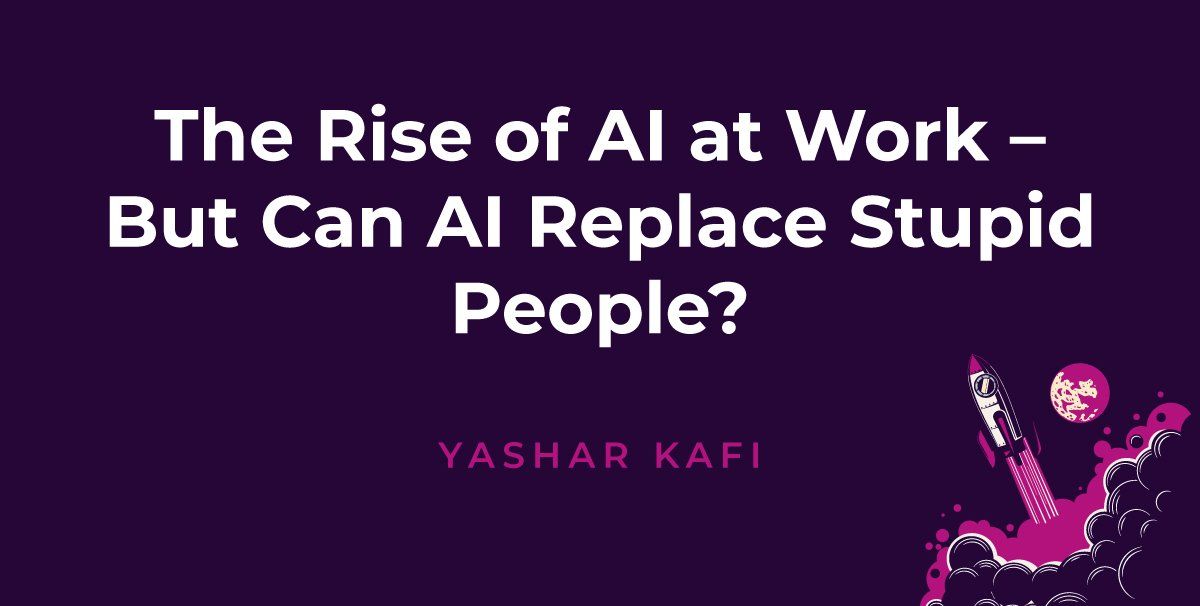The Rise of AI at Work – But Can AI Replace Stupid People?
Artificial Intelligence (AI) has become a hot topic, especially at the office. The reason is simple: Everyone has been impacted by the rise of AI in the workplace.
We are seeing things change, from how we order our fries at our favorite fast food joint to how we select our preferred menu item at our local restaurant and beyond. These innovations of AI have made many aspects of our daily lives easier and far more convenient, bringing whatever we desire at the touch of a hand. But our adoption of AI has led many to fear they will be deemed irrelevant in the modern workplace, replaced by bots altogether.
So, just how rational—or irrational—are these fears? While AI will replace some jobs and workers, I would wager that we will always need human interaction to keep the ball—or bot— rolling.
Experts Weigh In on AI
One expert—Sean Chou, CEO of Chicago-based AI startup Catalytic—is of the camp that believes that it is not time to panic. The reason for Chou’s calm demeanor? He asserts that technology will always need people.
The reason for this, as Chou puts it, is that robots really aren’t that smart, at least not yet or in the way we need them to be to replace all humans. Chou claims that even though robots are getting smarter all the time and serving the industry in new and innovative ways, he believes that we’re pretty far from “Terminator.”
Translation: There is a big difference between artificial intelligence and common sense/cognitive thinking. This means that there are still limitations with AI, and these limitations require human interaction for things to work together seamlessly.
So, while AI will undoubtedly be replacing specific jobs in the future (According to the World Economic Forum’s “The Future of Jobs Report 2020,” AI is expected to replace 85 million jobs worldwide by 2025), it will also be creating new jobs. The same report predicts 97 million new jobs by 2025, albeit in different fields than perhaps what we are used to and have been previously trained for.
So the situation is not dire, as the demand for workers will still be around—it just might not be in your preferred field.
Jobs That Will Disappear
Let’s be clear; some jobs seem like they should be replaced. After all, when things are joyless, who wants to do it? These are the occupations requiring mostly mundane tasks involving little or no creative thinking. Machines or intelligent systems can easily replace these roles.
Also, we are seeing in some areas that the use of machines instead of humans can often save exponentially on labor costs due to producing more in less time, with less (in some cases, zero) staff. Examples of these areas would be manufacturing workers, drivers, dispatchers, cashiers, etc.—anything involving repetitive work or work that can be easily automated.
For example, robots are already being used on assembly lines to expedite output. Self-driving cars are all the rage in upcoming technology (Hello, Tesla), and there are even trucking companies thinking of incorporating driverless trucks to transport their products. And don’t freak out, but there are even what I call “doc bots,” which are created to tackle even high-precision tasks like routine surgeries. These are only a few, but you can find even more here.
Jobs That Won’t Disappear
So, what jobs are still “safe” amid the rise of AI? Jobs that require thinking. We’ve discussed above how AI can replace repetitive, mostly mindless jobs. But AI can only go so far—meaning that AI can never truly replace roles requiring any type of problem-solving or critical/creative thinking (scientific innovation, teaching, medicine, art, etc.).
This logically makes sense, as it would be impossible for machines to tackle tasks that require any sort of decision-making beyond following the bare minimum, simple protocol. And what of emotional intelligence that is necessary for so many fields? Can you imagine being counseled through grief by a cold bot? Or trying to learn literature and art from a machine with no feelings? And imagine the hell that would break loose if AI were faced with the mountain of tough decisions CEOS and managers have to make daily involving super complex scenarios. Talk about asking for a world of chaos.
Yes, AI is impressive, but it is far from being at the point where it surpasses the power of people in many positions. And if you need any more assurance, here are even more roles that won’t be going anywhere anytime soon.
Final Thoughts
My thoughts best mirror Rodney Allen Brooks’ outlook on AI. An Australian roboticist and author, Brooks, said of AI: “Artificial Intelligence is a tool, not a threat.” Instead of fearing the loss of jobs to AI, we would be better spending our time working alongside AI, which will require a pivot on many of our parts.




